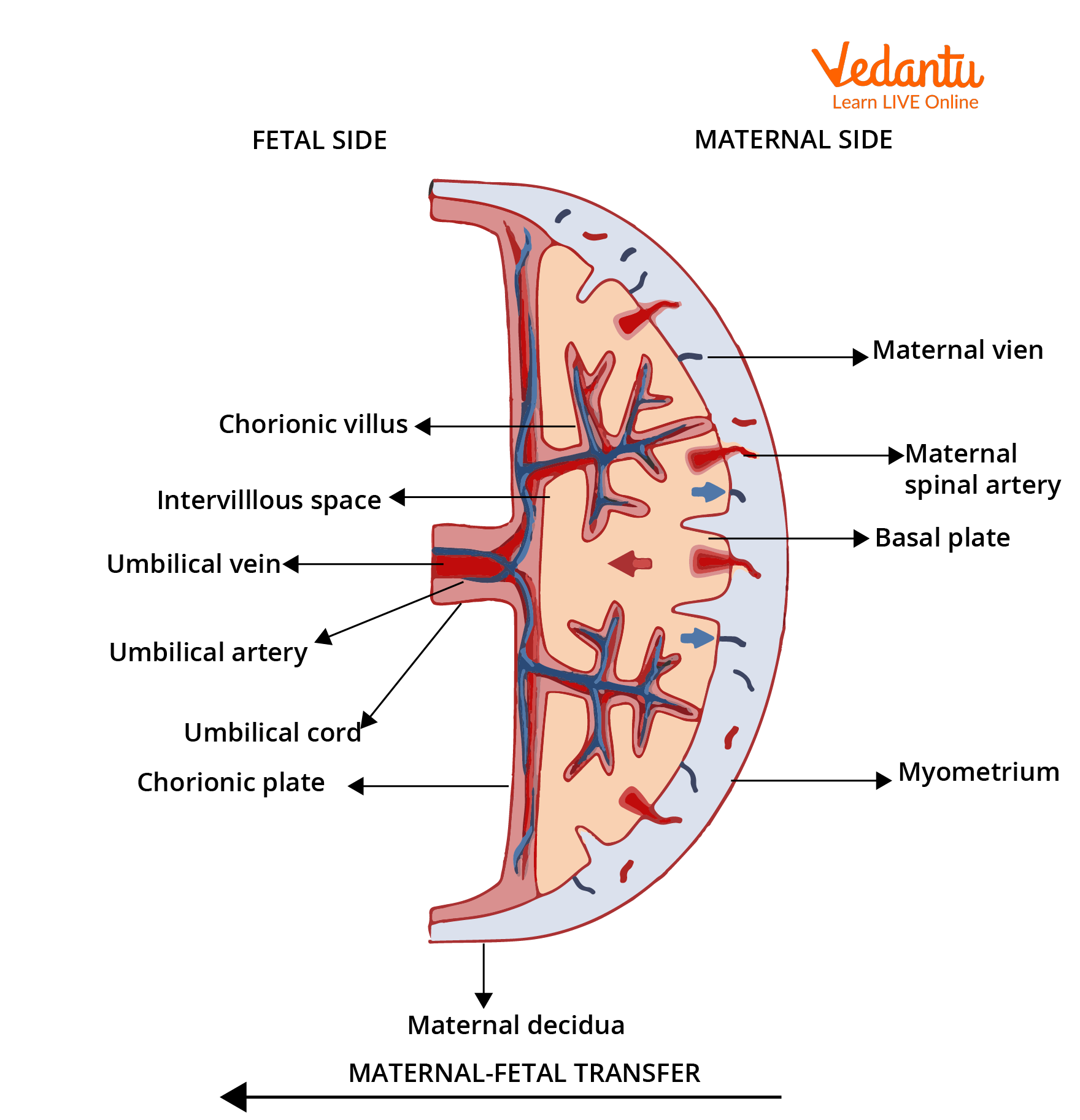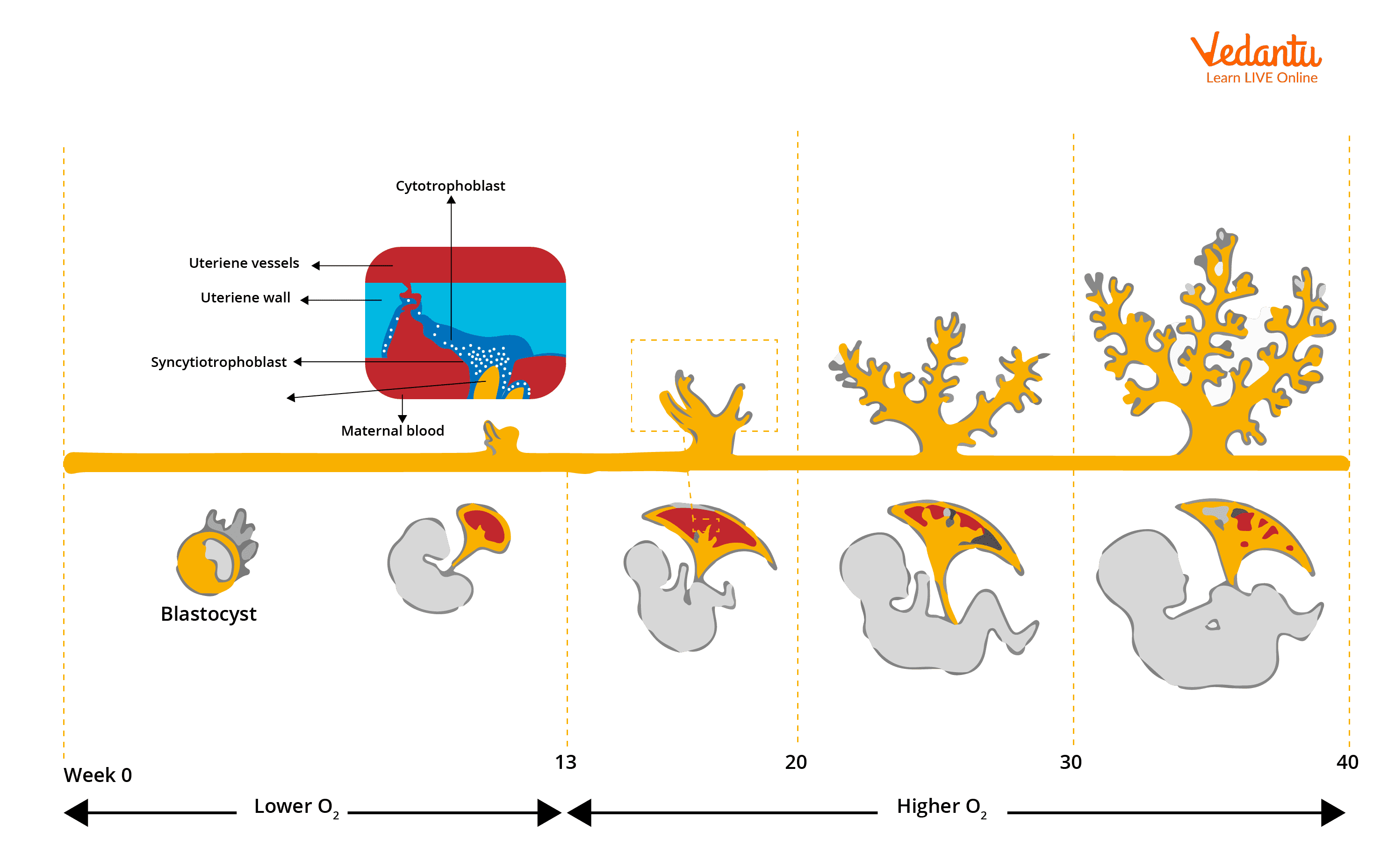Placenta: An Introduction
The placenta is a developing organ in the uterus during pregnancy. This structure provides oxygen and nutrients to a growing baby. It also cleans the baby's blood of waste products. The placenta attaches to the uterine wall and gives rise to the baby's umbilical cord.
It also produces a variety of pregnancy-related hormones, including lactogen, oestrogen and progesterone. Placentas are a distinguishing feature of placental mammals, but they are also found in marsupials and some non-mammals at various stages of development.
What is Placenta?
Placentation is a Greek term that means "flat cake."
The term "placenta" comes from the "human placenta", which is a flat, round mass that resembles a pancake.
In its broadest sense, this term refers to any region in a viviparous organism where maternal and embryonic tissues of any type are closely apposed and serve as a site for physiological exchange between parent and embryo.
It is a temporary organ.
The placenta performs the functions of the embryo's lung, intestine, kidney and endocrine glands.
It allows for the exchange of substances between maternal and foetal blood.
Structure of Placenta
Both maternal and embryonic tissue make up the placenta.
The chorion is the embryonic component of the placenta. It is composed of trophoblasts i.e. the cells that form the blastocyst's outer cell layer.
The placenta is foetal tissue that is embedded in the uterine wall and perfused with maternal blood via the uterine spiral arteries.
The decidua beneath the embryo is known as the decidua basalis, and it forms the maternal face of the placenta.
The placenta is divided into three layers:
The amnion is the name given to the innermost placental layer that surrounds the foetus.
The allantois is the placenta's middle layer (derived from the embryonic hindgut); blood vessels from the umbilicus pass through this membrane.
The chorion, the placenta's outermost layer, comes into contact with the endometrium. It is made up of two layers of cells: inner cytotrophoblast and outer syncytiotrophoblast.

Structure of Human Placenta
Development of Placenta
The placenta begins to develop very early in pregnancy, around week 4, with the implantation of the blastocyst into the maternal endometrium.
The blastocyst's outer layer develops into the trophoblast, which forms the placenta's outer layer.
The outer layer is further subdivided into two layers: the underlying cytotrophoblast layer and the overlying syncytiotrophoblast layer.
The syncytiotrophoblast is a continuous cell layer with multiple nuclei that covers the surface of the placenta. It develops from the differentiation and fusion of the underlying cytotrophoblast cells, a process that occurs throughout placental development.
As a result, the syncytiotrophoblast (also known as syncytium) contributes to the placental barrier function.
After about 12 weeks of pregnancy, the chorionic villi and uterine tissue interdigitate and form the placenta, a structural and functional unit between the developing embryo (foetus) and the maternal body.
By the end of the first trimester of pregnancy, week 14, the maternal blood supply to the placenta is complete.

Placental Development
Functions of Placenta
The placenta acts as an important endocrine gland during pregnancy.
Placental hormones include- oestrogen, progesterone, human chorionic gonadotropin(hCG) and human placental lactogen (hPL).
Placental hormones are required for pregnancy establishment and maintenance as well as for foetal growth.
It stores glycogen for the foetus prior to the formation of the liver.
It allows selective diffusion, preventing the passage of harmful materials from maternal blood to foetal blood.
Fun Facts about Placenta
It is the only disposable organ i.e. it naturally expels itself once its function is completed. Each pregnancy produces a new placenta to perfectly support the baby.
Many women consume their placenta after birth. Evidence suggests that mothers who eat their placentas after birth experience a variety of benefits including more balanced hormones, increased energy and milk supply, less postpartum bleeding and replenished iron stores.
The placenta has the unusual ability to grow and infiltrate the mother's body without being attacked by her immune system. The placenta's ability to evade the immune system is tightly controlled, and it knows when to stop infiltrating so as to not cause any harm to the mother.
The placenta is also known as the "tree of life", partly because of its life-sustaining function but also because its veins resemble those of a tree.
Conclusion
The placenta is the lifeline that connects a mother and her child. It is in the organ that the link between them is first established. Scientists believe that the placenta is the least understood human organ, despite being one of the most important organs in the body. This article gives insight into the structure known as the placenta which only develops during the pregnancy. It also talks about the different layers of the placenta, the role of the placenta, its developmental stages and its important functions.


FAQs on Placenta
1. What are the different placenta complications?
Placenta complications are harmful both for mother and baby. It includes:
Placenta accreta occurs when the placenta grows too deeply into the uterine wall. This can result in massive blood loss during or after delivery, which can be fatal.
Placental abruption occurs when the placenta separates from the womb wall before delivery. This can result in bleeding and your baby may not receive all of the nutrients he or she requires. Early delivery may be required in some cases.
Praevia Placenta: When the placenta partially or completely covers the cervix, which is the opening through which the baby will emerge. This condition is more common early in pregnancy and usually resolves as the placenta grows higher in the uterus.
2. What are the signs and symptoms of placental problems?
Some common placental problems include: bleeding in the cervix, pain in the abdomen, backache, contraction of the uterus and the rigidity of the uterus.
If a mother experiences vaginal bleeding at any point during the pregnancy, she should go to the hospital, especially if the bleeding is severe. Vaginal bleeding does not occur in every case of placenta previa. In fact, approximately one-third of people with placenta previa do not exhibit this symptom. Women who are older than the age of 35, had C-sections or had been pregnant before are more prone to these problems.
3. What are the steps to be taken to keep the placenta healthy?
The single most important factor in producing a healthy baby is a healthy placenta. The placenta, which is actually a part of the foetus, is essential for all aspects of pregnancy, from conception to delivery. Keeping it healthy includes lots of iron-rich foods because the baby absorbs a lot of iron from the mother's blood. Consuming nutrient-dense calories and iron-rich foods will aid in the maintenance of a healthy placenta and the prevention of conditions like iron deficiency anaemia. Exercising during the pregnancy also keeps the placenta healthy.










